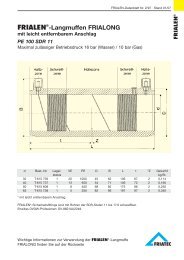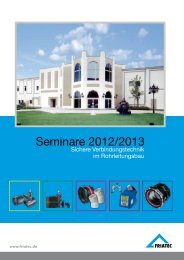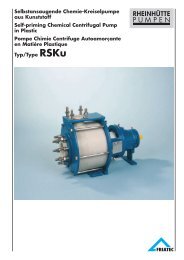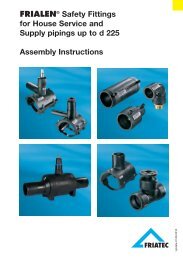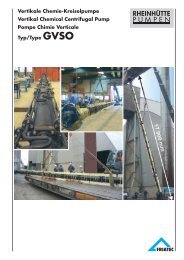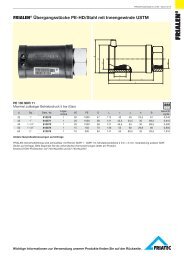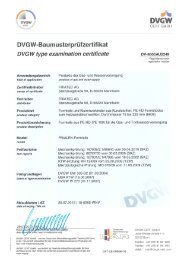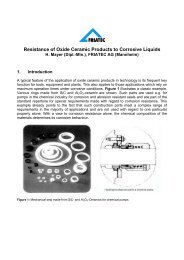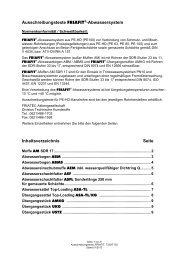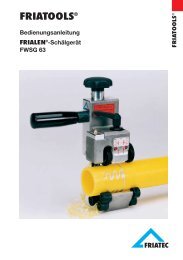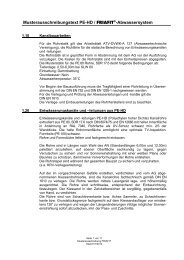Rheinhütte-Pumpen in der Titandioxidproduktion Rheinhütte-pumps ...
Rheinhütte-Pumpen in der Titandioxidproduktion Rheinhütte-pumps ...
Rheinhütte-Pumpen in der Titandioxidproduktion Rheinhütte-pumps ...
You also want an ePaper? Increase the reach of your titles
YUMPU automatically turns print PDFs into web optimized ePapers that Google loves.
<strong>Pumpen</strong> für die Produktion<br />
von Titandioxid<br />
Pumps for the production of<br />
titanium dioxide<br />
Pompes pour la production de<br />
dioxyde de titane
Die Verfahren <strong>der</strong> Titandioxidherstellung<br />
The process of manufactur<strong>in</strong>g titanium dioxide<br />
Le procédé de fabrication de TiO2<br />
Titanoxid (TiO2) ist aufgrund se<strong>in</strong>er e<strong>in</strong>zigartigen<br />
optischen Eigenschaften wie hoher<br />
Reflektionsgrad, hervorragendes Aufhellungsvermögen<br />
und <strong>der</strong> chemischen<br />
Stabilität das wichtigste Weiß-Pigment<br />
überhaupt. Aufgrund dieser Eigenschaften<br />
enthalten nahezu alle weiß gefärbten<br />
Gegenstände TiO2. Das Anwendungsspektrum<br />
ist breit gefächert und reicht von<br />
Farben, Lacken, Kunststoffen und Fasern<br />
bis h<strong>in</strong> zu Kosmetik, Salben und Zahnpasta.<br />
Weltweit werden über 3 Mio. Tonnen<br />
(steigende Tendenz) TiO2 produziert.<br />
TiO2 wird großtechnisch überwiegend<br />
nach dem Sulfat- o<strong>der</strong> nach dem Chloridverfahren<br />
hergestellt.<br />
Das seit 1917 bekannte Sulfatverfahren<br />
basiert auf den Rohstoffen Ilmenit<br />
(FeTiO3) o<strong>der</strong> Titanschlacke.<br />
Der fe<strong>in</strong>gemahlene Rohstoff wird mit<br />
Schwefelsäure bzw. Oleum (Konzentrationsbereich<br />
92 - 106 %) aufgeschlossen.<br />
Aufschluß:<br />
TiFeO3 + 2H2SO4 � TiOSO4 + FeSO4 +<br />
2H2O<br />
Durch Zugabe von Eisen-Schrott werden<br />
die <strong>in</strong> dem Aufschluß gelösten Eisen (III)<br />
Ionen zu E<strong>in</strong>sen (II) Ionen reduziert. Dies<br />
verh<strong>in</strong><strong>der</strong>t, daß Eisen (III) Ionen bei <strong>der</strong><br />
anschließenden Hydrolyse geme<strong>in</strong>sam mit<br />
Titanoxidhydrat TiO(OH)2 ausfallen und<br />
somit die Qualität <strong>der</strong> TiO2-Pigmente<br />
negativ bee<strong>in</strong>flussen.<br />
Für den nachfolgenden Prozeß muß die<br />
Lösung frei von Feststoffen se<strong>in</strong>.<br />
Nach Zugabe von Sedimentationshilfsmitteln<br />
wird die Lösung <strong>in</strong> E<strong>in</strong>dickern,<br />
Drehfiltern und darauffolgenden Filterpressen<br />
von unlöslichen Feststoffen<br />
gere<strong>in</strong>igt.<br />
Durch Abkühlen <strong>der</strong> Lösung kristallisiert<br />
Eisensulfatheptahydrat (FeSO4*7H2O =<br />
Grünsalz) aus, das <strong>in</strong> e<strong>in</strong>er Zentrifuge<br />
abgeschleu<strong>der</strong>t wird. Grünsalz kann u.a.<br />
als Rohstoff für Eisenoxid-Pigmente, als<br />
Rohstoff zur H2SO4 Herstellung durch<br />
Rösten, o<strong>der</strong> als Flockungsmittel bei <strong>der</strong><br />
Abwasseraufbereitung verwendet werden.<br />
Anschließend erfolgt durch E<strong>in</strong>leiten von<br />
Dampf die Hydrolyse des Titanoxidsulfates<br />
(TiOSO4) zu wasserunlöslichem<br />
Titanoxidhydrat TiO(OH)2. Bei <strong>der</strong> Hydrolyse<br />
entsteht e<strong>in</strong>e 20 - 23 %ige H2SO4 mit<br />
variierenden Anteilen an Eisensulfaten, die<br />
sogenannte Dünnsäure.<br />
2<br />
Due to its unique optical properties such<br />
as high reflectivity, excellent whiten<strong>in</strong>g<br />
capability and its chemical stability,<br />
titanium oxide (TiO2) is the most important<br />
pigment all round. Due to these properties<br />
virtually all white coloured objects<br />
conta<strong>in</strong> TiO2. The broad spectrum of<br />
use stretches from dyes, pa<strong>in</strong>ts, plastics<br />
and fibres right up to cosmetics, o<strong>in</strong>tments<br />
and toothpaste. Worldwide over 3<br />
million tonnes TiO2 are produced (and<br />
tend<strong>in</strong>g to <strong>in</strong>crease).<br />
Large scale production of TiO2 is ma<strong>in</strong>ly<br />
by the sulphate or the chloride process.<br />
The sulphate process, known s<strong>in</strong>ce<br />
1917 is based on the raw materials<br />
ilmenite (FeTiO3) or titanium slag.<br />
The f<strong>in</strong>ely ground raw material is extracted<br />
by sulphuric acid or oleum (concentration<br />
range 92 % - 106 %).<br />
Extraction:<br />
TiFeO3 + 2H2SO4 � TiOSO4 + FeSO4 +<br />
2H2O<br />
The iron (III) ions dissolved <strong>in</strong> the<br />
extraction process are reduced to iron<br />
(II) ions by the addition von iron-scrap.<br />
This prevents the iron (III) ions from<br />
precipitat<strong>in</strong>g with the titanium oxide hydrate<br />
TiO(OH)2 <strong>in</strong> the subsequent hydrolysis<br />
and thus negatively effect<strong>in</strong>g the<br />
quality of the TiO2 pigments.<br />
For the subsequent process the solution<br />
must be free from solids.<br />
After the addition of sedimentation<br />
agents, the solution is cleansed of <strong>in</strong>soluble<br />
solids <strong>in</strong> thickeners, rotary filters<br />
and then filter presses.<br />
By cool<strong>in</strong>g the solution, iron sulphate<br />
heptahydrate (FeSO4*7H2O = green<br />
salts) are crystallised out, and spun out<br />
<strong>in</strong> a centrifuge. Green salts can, among<br />
other th<strong>in</strong>gs, be used as raw material for<br />
iron oxide pigments, as raw material for<br />
the manufacture of H2SO4 by roast<strong>in</strong>g,<br />
or as a flocculant <strong>in</strong> the treatment of<br />
effluent.<br />
Then the <strong>in</strong>troduction of steam br<strong>in</strong>gs<br />
about the hydrolysis of the titanium<br />
oxide sulphate (TiOSO4) <strong>in</strong>to water<strong>in</strong>soluble<br />
titanium oxide hydrate<br />
TiO(OH)2. In the hydrolysis 20 - 23 %<br />
H2SO4 with vary<strong>in</strong>g proportions of iron<br />
sulphate is generated, so-called dilute<br />
acid.<br />
Le dioxyde de titane (TiO2) en raison de<br />
ses propriétés optiques uniques, comme<br />
son <strong>in</strong>dice de réfraction élevé, ses possibilités<br />
remarquables de blanchiment et<br />
sa stabilité chimique, est le pigment<br />
blanc le plus utilisé. Le large spectre<br />
d’utilisation s’étend des pe<strong>in</strong>tures, couleurs,<br />
plastiques, fibres et jusqu’aux<br />
cosmétiques, pommades et pâte dentifrice.<br />
Plus de 3 millions de tonnes de<br />
TiO2 sont produits dans le monde, avec<br />
une tendance constante à la hausse.<br />
Le TiO2 est fabriqué pr<strong>in</strong>cipalement à<br />
partir de 2 procédés: sulfate ou chlore.<br />
Connu depuis 1917, le procédé au<br />
«sulfate» utilise le m<strong>in</strong>erai ilménite<br />
(FeTiO3) ou les laitiers tétanifères<br />
(slags).<br />
Le m<strong>in</strong>erai f<strong>in</strong>ement moulu est mélangé<br />
à de l’acide sulfurique ou de l’oléum<br />
(concentration comprise entre 92-106 %).<br />
Dissolution:<br />
TiFeO3 + 2H2SO4 � TiOSO4 + FeSO4 +<br />
2H2O<br />
Par l’addition de ferraille, les ions fer (III)<br />
dissous sont réduits en ions fer (II). Ceci<br />
empêche pendant l’hydrolyse, les ions<br />
fer (III) de précipiter avec l’hydroxyde de<br />
titanyle TiO(OH)2 et a<strong>in</strong>si de détériorer la<br />
qualité du pigment TiO2.<br />
Le procédé ci-après exige une solution<br />
exempte de matières solides.<br />
Avec l’addition d’agents de sédimentation<br />
et l’utilisation de floculants, de filtres<br />
rotatifs et de filtres presse, il en résulte<br />
une solution sans solides en suspension.<br />
Par refroidissement de la solution, on<br />
provoque la cristallisation du sulfate<br />
ferreux (FeSO4*7H2O = sel vert), qui est<br />
ensuite déshydratée dans une centrifugeuse.<br />
Ce sulfate peut être utilisé, entre<br />
autres, comme matière première pour<br />
les pigments d’oxyde de fer, pour la<br />
fabrication de H2SO4 par grillage ou<br />
encore comme floculant pour le traitement<br />
des eaux résiduaires.<br />
Ensuite par <strong>in</strong>jection de vapeur, <strong>in</strong>tervient<br />
l’hydrolyse du sulfate de titanyle<br />
(TiOSO4) qui se transforme en hydroxyde<br />
de titanyle TiO(OH)2 <strong>in</strong>soluble. Avec<br />
cette hydrolyse, on obtient de l’acide<br />
dilué (20 - 23 % H2SO4) avec des<br />
concentrations variables de sulfate de<br />
fer.
Hydrolyse:<br />
TiOSO4 + 2H2O � TiO(OH)2 + H2SO4<br />
Das Titanoxidhydrat wird durch Abfiltration<br />
von <strong>der</strong> Dünnsäure gere<strong>in</strong>igt und<br />
anschließend <strong>in</strong> e<strong>in</strong>em Drehrohrofen<br />
(Kalz<strong>in</strong>ation) <strong>in</strong> TiO2 überführt.<br />
Kalz<strong>in</strong>ation:<br />
TiO(OH)2 � TiO2 + H2O<br />
Durch Impfen des Hydrolysates mit entsprechenden<br />
TiO2-Keimen, die Wahl <strong>der</strong><br />
geeigneten Glühtemperatur im Bereich<br />
von 800-1000 °C und durch Zugabe<br />
geeigneter E<strong>in</strong>stellchemikalien vor und<br />
nach <strong>der</strong> Kalz<strong>in</strong>ation läßt sich die<br />
gewünschte TiO2 Qualität erzielen. Das<br />
Sulfatverfahren liefert die beiden TiO2<br />
Modifikationen Rutil o<strong>der</strong> Anatas.<br />
Rutil besitzt aufgrund se<strong>in</strong>es günstigeren<br />
Brechungs<strong>in</strong>dexes e<strong>in</strong> besseres<br />
Deck-ungsvermögen als Anatas und<br />
ersche<strong>in</strong>t daher <strong>in</strong> hellerem Weiß.<br />
Anatas besitzt e<strong>in</strong>e ger<strong>in</strong>gere Härte und<br />
wird vorzugsweise dort e<strong>in</strong>gesetzt, wo<br />
es auf niedrigere Abrasion ankommt<br />
(z. B. Mattierung von Synthesefasern)<br />
Bei dem Sulfatverfahren treten H2SO4haltige<br />
Lösungen mit unterschiedlichen<br />
Konzentrationen an Feststoffen auf. Aufgrund<br />
<strong>der</strong> hervorragenden Beständigkeit<br />
<strong>in</strong> Schwefelsäure und <strong>der</strong> guten Verschleißeigenschaften<br />
werden daher an<br />
den wichtigsten Positionen <strong>Pumpen</strong> aus<br />
dem Werkstoff Siguss verwendet.<br />
Beispiele:<br />
P1 Typ RNSi Medium: 400 – 450 g/l<br />
TiOSO4 <strong>in</strong> max. 30 %-iger H2SO4,<br />
ungelöster Feststoffanteil ca. 400 g/l<br />
P2 Typ RNSi Medium: 400 – 450 g/l<br />
TiOSO4 <strong>in</strong> 10 %-iger H2SO4 mit<br />
gelösten Metallsulfaten<br />
P3 Typ RNSi Medium: 400 – 450 g/l<br />
TiOSO4 <strong>in</strong> 10 %-iger H2SO4, auskristallisiertes<br />
Eisensulfatheptahydrat<br />
P4 Typ RNSi Medium: 400 – 450 g/l<br />
TiOSO4 <strong>in</strong> 10 %-iger H2SO4<br />
P5 Typ RNSi Medium: 200 – 250 g/l<br />
TiO2 <strong>in</strong> 20 – 23%-iger H2SO4<br />
P6, P7 Typ RNSi Medium: TiO2-<br />
Suspension, 200 - 370 g/l TiO2 <strong>in</strong><br />
2 - 10 %- iger H2SO4<br />
Das vere<strong>in</strong>fachte Fließbild des Sulfatverfahrens<br />
f<strong>in</strong>den Sie auf Seite 8 als<br />
aufklappbare Seite.<br />
Hydrolysis:<br />
TiOSO4 + 2H2O � TiO(OH)2 + H2SO4<br />
The titanium oxide hydrate is purified by<br />
filter<strong>in</strong>g out the dilute acid and then<br />
converted <strong>in</strong>to TiO2 <strong>in</strong> a rotary oven<br />
(calc<strong>in</strong>ation).<br />
Calc<strong>in</strong>ation:<br />
TiO(OH)2 � TiO2 + H2O<br />
The desired TiO2 quality is achieved by<br />
seed<strong>in</strong>g the hydrolysate with suitable<br />
TiO2-seed crystals, by select<strong>in</strong>g a<br />
suitable anneal<strong>in</strong>g temperature <strong>in</strong> the<br />
range from 800 - 1000 °C and by the<br />
addition of suitable adjustment chemicals<br />
before and after the calc<strong>in</strong>ation. The<br />
sulphate process provides the two TiO2<br />
modifications rutile or anatase.<br />
Thanks to its more favourable refractive<br />
<strong>in</strong>dex rutile has a better coverage<br />
capability than anatase and so appears<br />
<strong>in</strong> a brighter white.<br />
Anatase has a lower hardness and is<br />
preferred for used where low abrasion<br />
occurs (e.g. production of synthetic<br />
fibres).<br />
In the sulphate process solutions occur<br />
which conta<strong>in</strong> H2SO4 with different concentrations<br />
of solids. Due to their excellent<br />
resistance to sulphuric acid and<br />
their good wear properties <strong>pumps</strong> made<br />
of Siguss material are used <strong>in</strong> the most<br />
critical positions.<br />
Example:<br />
P1 Type RNSi Medium: 400 – 450 g/l<br />
TiOSO4 <strong>in</strong> max. 30 % H2SO4, undissolved<br />
solids content approx. 400 g/l<br />
P2 Type RNSi Medium: 400 – 450 g/l<br />
TiOSO4 <strong>in</strong> 10 % H2SO4 with dissolved<br />
metal sulphates<br />
P3 Type RNSi Medium: 400 – 450 g/l<br />
TiOSO4 <strong>in</strong> 10 % H2SO4, crystallied iron<br />
sulphate heptahydrate<br />
P4 Type RNSi Medium: 400 – 450 g/l<br />
TiOSO4 <strong>in</strong> 10 % H2SO4<br />
P5 Type RNSi Medium: 200 – 250 g/l<br />
TiO2 <strong>in</strong> 20 – 23%-iger H2SO4<br />
P6, P7 Typ RNSi Medium: TiO2suspension,<br />
200-370 g/l TiO2 <strong>in</strong><br />
2-10 % H2SO4<br />
You will f<strong>in</strong>d the simplified flow chart<br />
for the sulphate process on the<br />
foldout Page 8.<br />
Hydrolyse:<br />
TiOSO4 + 2H2O � TiO(OH)2 + H2SO4<br />
L’hydroxyde de titanyle est séparé de<br />
l’acide dilué par filtration et ensuite<br />
transformé en TiO2 dans un four rotatif<br />
(calc<strong>in</strong>ation).<br />
Calc<strong>in</strong>ation:<br />
TiO(OH)2 � TiO2 + H2O<br />
Par l’addition de germes de TiO2 aux<br />
produits de l’hydrolyse, le choix judicieux<br />
de la température de recuit (entre<br />
800 à 1000 °C) et l’addition d’agents<br />
chimiques de régulation avant et après<br />
la calc<strong>in</strong>ation, on obtient la qualité<br />
voulue de TiO2. Le procédé au sulfate<br />
produit les deux variantes de TiO2 :<br />
rutile et anatase.<br />
Grâce à son <strong>in</strong>dice de réfraction plus<br />
élevé, le rutile possède un meilleur<br />
pouvoir couvrant que l’anatas et paraît<br />
a<strong>in</strong>si d’un blanc plus éclatant.<br />
L’anatase a une dureté <strong>in</strong>férieure et de<br />
ce fait, est surtout utilisé lorsqu’il faut<br />
m<strong>in</strong>imiser l’effet abrasif (par ex. pour les<br />
fibres de synthèse).<br />
Dans le procédé „ au sulfate“ on rencontre<br />
des solutions H2SO4 avec différentes<br />
concentrations de matières solides. En<br />
raison de son excellente résistance à<br />
l’acide sulfurique et de sa bonne tenue à<br />
l’érosion, les pompes situées sur les<br />
postes stratégiques, sont en Siguss.<br />
Exemples:<br />
P1 Type RNSi Fluide: maxi 30 % H2SO4<br />
avec 400-450 g/l TiOSO4, matières en<br />
suspension env. 400 g/l<br />
P2 Type RNSi Fluide: 10 % H2SO4<br />
avec 400-450 g/l TiOSO4 et des sulfates<br />
métalliques dissous.<br />
P3 Type RNSi Fluide: 10 % H2SO4<br />
avec 400-450 g/l TiOSO4<br />
et des cristaux de sulfate de fer.<br />
P4 Type RNSi Fluide: 10 % H2SO4<br />
avec 400-450 g/l TiOSO4<br />
P5 Type RNSi Fluide: 20 – 23% H2SO4<br />
avec 200 – 250 g/l TiO2<br />
P6, P7 Typ RNSi Fluide: 2 - 10 %<br />
H2SO4 avec une suspension de 200 à<br />
370 g/l TiO2<br />
Le schéma technologique du procédé<br />
„sulfate“ se trouve à la page 8 (feuille<br />
pliable).<br />
3
Bei dem Chloridverfahren werden Rohstoffe<br />
mit hohem TiO2-Gehalt wie Rutilsande<br />
o<strong>der</strong> Titanschlacke verwendet.<br />
Das im Rohstoff vorhandene TiO2 wird<br />
mit calc<strong>in</strong>iertem Petrolkoks und Chlor zu<br />
Titantetrachlorid TiCl4 umgesetzt. Die<br />
Reaktion f<strong>in</strong>det <strong>in</strong> e<strong>in</strong>em Fließbettreaktor<br />
bei e<strong>in</strong>er Temperatur zwischen 800 -<br />
1200 °C statt. Der Prozeß ist kont<strong>in</strong>uierlich.<br />
Chlorierung:<br />
TiO2 + 2Cl2 + C � TiCl4 + CO2<br />
o<strong>der</strong><br />
FeTiO3+3Cl2 +2C�TiCl4+FeCl2<br />
+CO+CO2<br />
Das bei dem Prozeß anfallende Eisen(II)<br />
Chlorid FeCl2 wird <strong>in</strong> Wasser gelöst und<br />
abgetrennt. Die durch die Restfeuchte<br />
<strong>der</strong> Schlacke entstehende Salzsäure HCl<br />
wird ebenfalls entfernt und als Rohstoff<br />
verkauft.<br />
Die Re<strong>in</strong>igung des gasförmigen TiCl4<br />
erfolgt zunächst durch Abkühlen auf<br />
e<strong>in</strong>e Temperatur unter 0°C. Das kondensierte<br />
flüssige TiCl4 wird durch Absetzen<br />
von festoffhaltigen Verunre<strong>in</strong>igungen befreit.<br />
Durch Zugabe von Reduktionsmitteln<br />
(z.B. Ölsäure, H2S) und Destillation<br />
werden unerwünschte Chloride wie<br />
SiCl4, FeCl3, VOCl2 vom TiCl4 entfernt.<br />
Anschließend wird das gere<strong>in</strong>igte Gas<br />
bei Temperaturen von 900 – 1400 °C mit<br />
Sauerstoff zu TiO2-Pigment und Chlor<br />
umgesetzt. Das entstandene Chlor wird<br />
dem Reaktionsprozeß wie<strong>der</strong> zugeführt.<br />
Die Zugabe von bis zu 5% AlCl3 vor <strong>der</strong><br />
Verbrennung unterstützt die Bildung von<br />
fe<strong>in</strong>teiligem Rutil. Durch gezielte Nachbehandlungsmaßnahmen<br />
können die<br />
gewünschten Rutilqualitäten e<strong>in</strong>gestellt<br />
werden.<br />
Oxidation:<br />
TiCl4 + O2 � TiO2 + 2Cl2<br />
Das Chloridverfahren liefert <strong>in</strong> <strong>der</strong> Regel<br />
nur die TiO2-Modifikation Rutil.<br />
Bei <strong>der</strong> Herstellung von TiO2 nach dem<br />
Chloridverfahren fallen auch aggressive<br />
und abrasive Abfallstoffe an.<br />
P2, P4 In <strong>der</strong> Gasre<strong>in</strong>igung und <strong>in</strong> <strong>der</strong><br />
Aufbereitung von HCl und FeCl2 haben<br />
sich <strong>Pumpen</strong> des Typs CPDR, RCNKu<br />
und RVKu aus PP, PE 1000 o<strong>der</strong> PVDF<br />
gut bewährt.<br />
P1 Die abrasive metallchloridhaltige<br />
Feststofflösung, die <strong>in</strong> <strong>der</strong> Gasre<strong>in</strong>igung<br />
4<br />
Raw materials with a high TiO2 content,<br />
such as rutile sands or titanium slag,<br />
are used <strong>in</strong> the chloride process. The<br />
TiO2 present <strong>in</strong> the raw material is<br />
converted <strong>in</strong>to titanium tetrachloride<br />
TiCl4 with calc<strong>in</strong>ed petroleum coke and<br />
chlor<strong>in</strong>e. The reaction takes place <strong>in</strong> a<br />
fluid bed reactor, at a temperature<br />
between 800-1200 °C. The process is<br />
cont<strong>in</strong>uous.<br />
Chlor<strong>in</strong>ation:<br />
TiO2 + 2Cl2 + C � TiCl4 + CO2<br />
or<br />
FeTiO3+3Cl2 +2C�TiCl4+FeCl2<br />
+CO+CO2<br />
The iron(II) chloride FeCl2 occurr<strong>in</strong>g <strong>in</strong><br />
the process is dissolved <strong>in</strong> water and<br />
separated out. The hydrochloric acid<br />
HCl occurr<strong>in</strong>g due to the residual<br />
moisture <strong>in</strong> the slag is also removed and<br />
sold as a raw material.<br />
The purification of the gaseous TiCl4 is<br />
achieved by first cool<strong>in</strong>g it down to a<br />
temperature below 0 °C. The condensed<br />
liquid TiCl4 is cleared of impurities<br />
conta<strong>in</strong><strong>in</strong>g solids by sedimentation.<br />
Unwanted chlorides such as SiCl4,<br />
FeCl3, VOCl2 are removed from the TiCl4<br />
by the addition of reduc<strong>in</strong>g agents (e.g.<br />
oleic acid, H2S) and distillation.<br />
The purified gas is then converted to<br />
TiO2 pigments and chlor<strong>in</strong>e with oxygen,<br />
at temperatures of 900 – 1400 °C. The<br />
chlor<strong>in</strong>e formed is fed back <strong>in</strong>to the<br />
reaction process. The addition of up to<br />
5% AlCl3 before combustion promotes<br />
the formation of f<strong>in</strong>e particle rutile. The<br />
quality of rutile required can be adjusted<br />
by specific after treatment.<br />
Oxidation:<br />
TiCl4 + O2 � TiO2 + 2Cl2<br />
The chloride process usually provides<br />
only the TiO2-modification rutile.<br />
Aggressive and abrasive waste products<br />
also occur when manufactur<strong>in</strong>g TiO2 by<br />
the chloride process.<br />
P2, P4 Pump types CPDR, RCNKu and<br />
RVKu made of PP, PE 1000 or PVDF have<br />
proven their worth <strong>in</strong> gas purification<br />
and <strong>in</strong> the preparation of HCl and FeCl2.<br />
P1 The abrasive solids solution conta<strong>in</strong><strong>in</strong>g<br />
metal chlorides, which is<br />
generated <strong>in</strong> the gas purification after<br />
Dans le procédé «au chlore» on utilise<br />
des m<strong>in</strong>erais à haute teneur en TiO2<br />
comme le rutile ou le m<strong>in</strong>erai de titane.<br />
Le TiO2 contenu dans ses m<strong>in</strong>erais va<br />
être transformé, grâce à l’action du coke<br />
et du chlore, en tétrachlorure de titane<br />
TiCl4. Cette transformation se déroule<br />
dans un réacteur à lit fluidisé, à une<br />
température de 800 à 1200 °C. Le<br />
procédé est cont<strong>in</strong>u.<br />
Chloration:<br />
TiO2 + 2Cl2 + C � TiCl4 + CO2<br />
ou<br />
FeTiO3+3Cl2 +2C�TiCl4+FeCl2<br />
+CO+CO2<br />
Dans ce procédé, le chlorure ferreux<br />
FeCl2 va être dissous dans l’eau et<br />
séparé. En raison de l’humidité résiduelle,<br />
le laitier contient de l’acide chlorhydrique<br />
HCl qui sera également isolé et vendu<br />
comme matière première.<br />
La purification du TiCl4 sous forme<br />
gazeuse s’effectue d’abord par refroidissement<br />
à une température < à 0 °C. Le<br />
TiCl4 concentré obtenu sera libéré de<br />
ses impuretés (matières solides) par<br />
décantation. A l’aide d’addition de<br />
réducteurs (par exemple, acide oléique,<br />
H2S) et par distillation, les chlorures<br />
<strong>in</strong>désirables comme SiCl4, FeCl3, VOCl2<br />
seront séparés du TiCl4.<br />
Au f<strong>in</strong>al, le gaz enrichi sera transformé, à<br />
une température de 900 – 1400 °C avec<br />
de l’oxygène, en pigment TiO2 et chlore.<br />
Ce <strong>der</strong>nier sera reconduit dans le<br />
procédé de réaction. La proportion de<br />
AlCl3 (5% maxi) avant l’<strong>in</strong>c<strong>in</strong>ération<br />
favorise la formation de f<strong>in</strong>es particules<br />
de rutile. Grâce à différentes conditions<br />
de traitement, les qualités souhaitées de<br />
rutile peuvent être obtenues.<br />
Oxydation:<br />
TiCl4 + O2 � TiO2 + 2Cl2<br />
Le procédé «chlore» ne fournit normalement<br />
que le TiO2 issu du rutile.<br />
Lors de la production du TiO2, ce<br />
procédé crée également des sousproduits<br />
corrosifs et abrasifs.<br />
P2, P4 Dans l’épuration des gaz et dans<br />
le traitement de HCl et FeCl2 , les<br />
pompes de type CPDR, RCNKu et<br />
RVKu en PP, PE 1000 ou PVDF ont<br />
prouvé leur fiabilité.<br />
P1 Les solutions solides, abrasives<br />
contenant des chlorures métalliques, qui
nach dem Reaktor entsteht wird mit<br />
<strong>Pumpen</strong> des Typs RNSiC aus dem<br />
Werkstoff SiSiC o<strong>der</strong> <strong>Pumpen</strong> des Typs<br />
FNC aus FRIKORUND ® geför<strong>der</strong>t.<br />
P3 Im Bereich <strong>der</strong> TiO2-Re<strong>in</strong>igung s<strong>in</strong>d<br />
Normpumpen Typ RN aus Siguß und<br />
1.4136 S im E<strong>in</strong>satz<br />
Vere<strong>in</strong>fachtes Fließbild des Chloridverfahrens<br />
1) Mahlaggregat<br />
2) Silo<br />
3) Wirbelbettreaktor<br />
4) Kühlturm<br />
5) Abtrennung <strong>der</strong><br />
Metallchloride<br />
6) TiCl4-<br />
Kondensation<br />
7) Tank<br />
8) Kühler<br />
9) Vanadium-<br />
Reduktion<br />
10) Destillation<br />
11) Verdampfer<br />
12) Überhitzer<br />
13) Sauerstoffüberhitzer<br />
14) Brenner<br />
15) Kühlwendel<br />
16) Filter<br />
17) TiO2-Re<strong>in</strong>igung<br />
18) Silo<br />
19) Gasre<strong>in</strong>igung<br />
20) Abgasre<strong>in</strong>igung<br />
21) Chlorverflüssigung<br />
the reactor, is conveyed by <strong>pumps</strong> of<br />
the RNSiC type, made of SiSiC material<br />
or by <strong>pumps</strong> of the FNC type made of<br />
FRIKORUND ® .<br />
P3 Type RN standardised <strong>pumps</strong> made<br />
of Siguss and 1.4136 S are used <strong>in</strong> the<br />
area of TiO2 purification<br />
Simplified flow chart for the Chloride<br />
process<br />
1) Gr<strong>in</strong>d<strong>in</strong>g unit<br />
2) Silo<br />
3) Fluidised bed<br />
reactor<br />
4) Cool<strong>in</strong>g tower<br />
5) Separation of the<br />
metal chlorides<br />
6) TiCl4condensation<br />
7) Tank<br />
8) Cooler<br />
9) Vanadium<br />
reduction<br />
10) Distillation<br />
11) Evaporator<br />
12) Super heater<br />
13) Oxygen super<br />
heater<br />
14) Burner<br />
15) Cool<strong>in</strong>g coil<br />
16) Filter<br />
17) TiO2-purification<br />
18) Silo<br />
19) Gas purification<br />
20) Flue gas clean<strong>in</strong>g<br />
21) Chlor<strong>in</strong>e<br />
liquefaction<br />
se forment après le réacteur dans la<br />
purification des gaz, sont véhiculées par<br />
les pompes type RNSiC en SiSiC ou<br />
type FNC en FRIKORUND ® .<br />
P3 Dans le secteur de la concentration<br />
du TiO2, on utilise les pompes normalisées<br />
type RN en Siguss et en 1.4136 S.<br />
Schéma simplifié du procédé<br />
«au chlore»<br />
1) Broyeur à<br />
boules/sécheur<br />
2) Silo<br />
3) Réacteur à lit fluidisé<br />
4) Tour de refroidissement<br />
5) Extraction des<br />
chlorures métalliques<br />
6) Condensation du TiCl4<br />
7) Réservoir<br />
8) Refroidisseur<br />
9) Réduction du vanadium<br />
10) Distillation<br />
11) Evaporateur<br />
12) Surchauffeur<br />
13) Surchauffeur<br />
d’oxygène<br />
14) Brûleur<br />
15) Hélice de<br />
refroidissement<br />
16) Filtre<br />
17) Concentration<br />
du TiO2<br />
18) Silo<br />
19) Purification du<br />
gaz<br />
20) Traitement des gaz<br />
21) Condensation<br />
du chlore<br />
5
Dünnsäuree<strong>in</strong>dampfung<br />
Bei dem Titanerzaufschluß nach dem<br />
Sulfatverfahren entstehen pro Tonne<br />
TiO2 ca. sechs bis acht Tonnen<br />
Dünnsäure.<br />
Die Dünnsäure ist e<strong>in</strong>e 20 - 23 %ige<br />
Schwefelsäure mit e<strong>in</strong>em Anteil von<br />
etwa 12% Metallsulfaten. Das Ziel <strong>der</strong><br />
Aufkonzentrierung ist die Gew<strong>in</strong>nung<br />
e<strong>in</strong>er Schwefelsäure, die für den Aufschluß<br />
wie<strong>der</strong> verwendet werden kann.<br />
Je nach Ausgangsstoff für die TiO2-Herstellung<br />
benötigt man e<strong>in</strong>e unterschiedliche<br />
H2SO4-Konzentration. Für den Aufschluß<br />
von Ilmenit reicht e<strong>in</strong>e 70%ige<br />
H2SO4, für den Aufschluß von TiO2-<br />
Schlacke wird e<strong>in</strong>e Konzentration von<br />
95% benötigt.<br />
Die Aufarbeitung <strong>der</strong> Dünnsäure<br />
geschieht <strong>in</strong> <strong>der</strong> Regel <strong>in</strong> mehrstufigen<br />
Vakuumverdampfern. Die entstandene<br />
etwa 70%ige H2SO4 bildet mit den enthaltenen<br />
Metallsulfaten e<strong>in</strong>e Suspension<br />
und fließt mit e<strong>in</strong>er Temperatur von etwa<br />
115 °C <strong>in</strong> e<strong>in</strong>en Reifebehälter, kühlt dort<br />
auf 50 °C ab und wird anschließend über<br />
Filterpressen abfiltert.<br />
Die abgefilterten Metallsulfate können<br />
anschließend z.B. zur Schwefelsäureherstellung<br />
durch Rösten verwendet<br />
werden. Die 70%ige H2SO4 steht zum<br />
Aufschluß von Ilmenit zur Verfügung<br />
o<strong>der</strong> wird über e<strong>in</strong>e weitere Aufkonzentrierungsstufe<br />
(Verdampfer o<strong>der</strong> Spaltanlage)<br />
zu 80%iger H2SO4 aufgearbeitet.<br />
E<strong>in</strong>e weitere Aufkonzentrierung kann<br />
durch Mischen mit Oleum erfolgen.<br />
Aufgrund <strong>der</strong> kritischen Temperaturen<br />
<strong>der</strong> Schwefelsäure und <strong>der</strong> starken Feststoffbelastung<br />
(bis zu 36% FeSO4*H2O)<br />
werden hohe Anfor<strong>der</strong>ungen an die verwendeten<br />
<strong>Pumpen</strong> gestellt.<br />
In den unterschiedlichen Stufen des E<strong>in</strong>dampfprozesses<br />
werden daher <strong>Pumpen</strong><br />
des Typs RSU (P1, P2, P3, P6) und<br />
RNSi (P4, P5) aus dem Werkstoff Siguß<br />
bevorzugt e<strong>in</strong>gesetzt.<br />
6<br />
Concentration of dilute acid<br />
In the extraction of titanium ore by the<br />
sulphate process about six to eight<br />
tonnes of dilute acid are generated for<br />
each tonne of TiO2.<br />
The dilute acid is a 20 - 23 % sulphuric<br />
acid with a metal sulphate content of<br />
around 12%. The aim of the concentration<br />
process is to recover sulphuric acid<br />
that can be reused for the extraction.<br />
Dependent on the start<strong>in</strong>g material for<br />
the manufacture of TiO2, different concentrations<br />
of H2SO4 are needed. For<br />
the extraction from ilmenite 70%ige<br />
H2SO4 is adequate, the extraction from<br />
TiO2 slag requires a concentration of<br />
95%.<br />
As a rule, the preparation of the dilute<br />
acid takes place <strong>in</strong> multi-stage vacuum<br />
evaporators. The around 70% H2SO4<br />
obta<strong>in</strong>ed forms a suspension with the<br />
metal sulphates conta<strong>in</strong>ed and flows<br />
<strong>in</strong>to a maturation tank at a temperature<br />
of around 115 °C, cools down to 50 °C<br />
there and is then filtered out through<br />
filter presses.<br />
The metal sulphates filtered out can then<br />
be used e.g. for the manufacture of<br />
sulphuric acid- by roast<strong>in</strong>g. The 70%<br />
H2SO4 is available for the extraction<br />
from ilmenite or is processed up to 80%<br />
H2SO4 through a further concentration<br />
stage (evaporator or crack<strong>in</strong>g plant).<br />
Further concentration can be achieved<br />
by mix<strong>in</strong>g with oleum.<br />
The critical temperatures of the sulphuric<br />
acid and high contam<strong>in</strong>ation with<br />
solids (up to 36% FeSO4*H2O), make<br />
high demands on the <strong>pumps</strong> used.<br />
This is why <strong>pumps</strong> of the types RSU<br />
(P1, P2, P3, P6) and RNSi (P4, P5)<br />
made of Siguss material are employed <strong>in</strong><br />
the different stages of the concentration<br />
process.<br />
Concentration de l’acide dilué<br />
Dans le procédé au « sulfate » lors de la<br />
dissolution du m<strong>in</strong>erai de titane, une<br />
production d’une tonne de TiO2 fournit<br />
six à huit tonnes d’acide dilué.<br />
L’acide dilué est un acide sulfurique à<br />
20 - 30 % avec environ 12% de sulfates<br />
métalliques. Le but de la concentration<br />
est d’obtenir de nouveau un acide<br />
utilisable à la dissolution du m<strong>in</strong>erai.<br />
Selon le type de m<strong>in</strong>erai utilisé pour la<br />
fabrication du TiO2, on utilise des concentrations<br />
différentes de H2SO4. Pour<br />
la dissolution de l’ilménite, du H2SO4 à<br />
70% est suffisant et pour celle des<br />
laitiers de TiO2, du H2SO4 à 95% est<br />
nécessaire.<br />
Le retraitement de l’acide dilué s’élabore<br />
généralement dans des évaporateurs à<br />
plusieurs étages. On obtient a<strong>in</strong>si du<br />
H2SO4 à 70%, qui avec les sulfates<br />
métalliques, forme une suspension<br />
d’une température d’environ 115 °C.<br />
Celle-ci passe dans un réservoir de<br />
maturation où elle est refroidie à 50 °C<br />
et ensuite filtrée dans des filtres-presse.<br />
Les sulfates métalliques filtrés peuvent<br />
être utilisés dans la fabrication d’acide<br />
sulfurique par grillage. Le H2SO4 à 70%<br />
peut être utilisé pour la dissolution de<br />
l’ilménite ou par évaporation, être concentré<br />
à 80%. Une plus forte concentration<br />
ne peut être obtenue qu’avec l’addition<br />
d’oléum.<br />
Les températures élevées de l’acide<br />
sulfurique et la quantité importante de<br />
solides (jusqu’à 36% de FeSO4*H2O)<br />
impliquent des exigences élevées aux<br />
pompes en service.<br />
De ce fait, dans les différentes étapes du<br />
procédé de concentration, on utilise de<br />
préférence des pompes en Siguss, type<br />
RSU (P1, P2, P3, P6) et RNSi (P4, P5).
Vere<strong>in</strong>fachtes Fließbild <strong>der</strong> Dünnsäureaufbereitung<br />
P1, P2, P3, P6<br />
Umwälzpumpen Typ RSU<br />
P4, P5<br />
Chemie-Normpumpen Typ RNSi<br />
7, 8, 9, 10<br />
Umlaufverdampfer mit außenliegendem<br />
Wärmetauscher<br />
11 Reifestation<br />
12 Filtration<br />
Simplified flow chart for the concentration<br />
of dilute acid<br />
P1, P2, P3, P6<br />
Axial flow circulat<strong>in</strong>g <strong>pumps</strong><br />
type RSU<br />
P4, P5<br />
Standardized chemical-<strong>pumps</strong><br />
type RNSi<br />
7, 8, 9, 10<br />
Circulatory evaporator with external<br />
heat exchangers<br />
11 Maturation station<br />
12 Filtration<br />
Schéma simplifié de la concentration<br />
de l’acide dilué<br />
P1, P2, P3, P6<br />
Pompes chimie de circulation<br />
type RSU<br />
P4, P5<br />
Pumpes chimie normalisées<br />
type RNSi<br />
7, 8, 9, 10<br />
Circuit d’évaporation avec<br />
échangeur de chaleur extérieur<br />
11 Unité de maturation<br />
12 Filtration<br />
7
Vere<strong>in</strong>fachtes Fließbild des<br />
Sulfatverfahrens<br />
1) Kugelmühle /<br />
Trockner<br />
2) Sieb<br />
3) Magnetabschei<strong>der</strong><br />
4) Zyklon<br />
5) Silo<br />
6) Aufschlussgefäß<br />
7) E<strong>in</strong>dicker<br />
8) Drehfilter<br />
9) Filterpresse<br />
10) Kristallisator<br />
11) Zentrifuge<br />
12) Vakuumverdampfer<br />
13) Vorwärmer<br />
14) Hydrolysebehälter<br />
15) Kühler<br />
16) Moore-Filter<br />
17) Bleichbehälter<br />
18) Dotierungsbehälter<br />
19) Drehfilter zur<br />
Entwässerung<br />
20) Drehrohrofen<br />
21) Kühler<br />
Simplified flow chart for<br />
the Sulphate process<br />
1) Ball mill / dryer<br />
2) Sieve<br />
3) Magnetic separator<br />
4) Cyclone<br />
5) Silo<br />
6) Extraction vessel<br />
7) Thickener<br />
8) Rotary filter<br />
9) Filter press<br />
10) Crystalliser<br />
11) Centrifuge<br />
12) Vacuum evaporator<br />
13) Preheater<br />
14) Hydrolysis tank<br />
15) Cooler<br />
16) Moore Filter<br />
17) Bleach conta<strong>in</strong>er<br />
18) Dop<strong>in</strong>g tank<br />
19) Rotary filter<br />
to extract water<br />
20) Rotary oven<br />
21) Cooler<br />
Schéma simplifié du procédé<br />
«au sulfate»<br />
1) Broyeur à<br />
boules/sécheur<br />
2) Filtre<br />
3) Séparateur<br />
magnétique<br />
4) Cyclone<br />
5) Silo<br />
6) Cuve de<br />
dissolution<br />
7) Décanteur<br />
8) Filtre rotatif<br />
9) Filtre-presse<br />
10) Cristalliseur<br />
11) Centrifugeuse<br />
12) Evaporateur<br />
sous vide<br />
13) Préchauffe<br />
14) Bac d’hydrolyse<br />
15) Refroidisseur<br />
16) Filtre à tourbe<br />
17) Cuve de<br />
blanchiment<br />
18) Cuve de dopage<br />
19) Filtre rotatif pour<br />
eaux résiduaires<br />
20) Four rotatif<br />
21) Refroidisseur<br />
8
9<br />
RNSi..B<br />
CPDR<br />
Chemie-Normpumpe Typ RNSi..B aus Eisensiliziumguß zur För<strong>der</strong>ung<br />
aller H2SO4-haltigen Lösungen beim Sulfatverfahren und<br />
<strong>der</strong> unterschiedlichen Dünnsäuren bei <strong>der</strong> Aufbereitung.<br />
Standardised chemical pump Type RNSi..B made of cast silicon<br />
iron for pump<strong>in</strong>g all solutions conta<strong>in</strong><strong>in</strong>g H2SO4-<strong>in</strong> the sulphate<br />
process and the various dilute acids dur<strong>in</strong>g their preparation.<br />
Pompe chimie normalisée type RNSi..B en fonte au silicium<br />
(Siguss) pour le transfert de toutes les solutions contenant de<br />
l’acide sulfurique (H2SO4 du procédé au «sulfate» et divers acides<br />
dilués du traitement.<br />
Chemie-Normpumpe Typ CPDR aus massivem Kunststoff mit<br />
metallischer Vollpanzerung zum E<strong>in</strong>satz <strong>in</strong> <strong>der</strong> Gasre<strong>in</strong>igung und<br />
<strong>der</strong> HCl-Aufbereitung beim Chloridverfahren.<br />
Standardised chemical pump Type CPDR <strong>in</strong> solid plastic with<br />
metal armour<strong>in</strong>g, for use <strong>in</strong> gas purification and the preparation of<br />
HCl <strong>in</strong> the chloride process.<br />
Pompe chimie normalisée type CPDR en plastique massif (avec<br />
un bl<strong>in</strong>dage métallique) pour utilisation dans le traitement des gaz<br />
et la préparation de HCl du procédé «au chlore».<br />
Chemie-Normpumpe Typ FNC aus technischer Keramik<br />
FRIKORUND ® zur För<strong>der</strong>ung abrasiver Medien.<br />
Standardised chemical pump Type FNC made of FRIKORUND ®<br />
eng<strong>in</strong>eer<strong>in</strong>g ceramic material for pump<strong>in</strong>g abrasive media.<br />
Pompe chimie normalisée type FNC, en céramique<br />
FRIKORUND ® , pour le transfert des fluides abrasifs.<br />
Chemie-Umwälzpumpe Typ RSU aus Eisensiliziumguß zur För<strong>der</strong>ung<br />
<strong>der</strong> feststoffbeladenen Dünnsäuren bei <strong>der</strong> Aufbereitung.<br />
Chemical circulation pump Type RSU made of cast silicon iron for<br />
the pump<strong>in</strong>g dur<strong>in</strong>g the preparation of dilute acids contam<strong>in</strong>ated<br />
with solids.<br />
Pompe chimie de circulation type RSU, en fonte au silicium, pour<br />
le transfert d’acides dilués et chargés, pour la concentration.<br />
FNC RSU
3.00.0018-0106 d-e-f<br />
<strong>Rhe<strong>in</strong>hütte</strong>-<strong>Pumpen</strong> <strong>in</strong> <strong>der</strong> <strong>Titandioxidproduktion</strong><br />
<strong>Rhe<strong>in</strong>hütte</strong>-<strong>pumps</strong> <strong>in</strong> the production of titanium dioxide<br />
Pompes <strong>Rhe<strong>in</strong>hütte</strong> pour la production de dioxyde de titane<br />
Chemie-Normpumpen Typ RNSi zur För<strong>der</strong>ung von<br />
Dünnsäure.<br />
Standardized chemical <strong>pumps</strong> type RNSi for handl<strong>in</strong>g weak<br />
acid.<br />
Pompes chimie normalisée type RNSi pour véhiculer des<br />
acides dilués.<br />
FRIATEC-<strong>Rhe<strong>in</strong>hütte</strong> GmbH & Co. KG<br />
Postfach / P.O.B. 12 05 45 • D-65083 Wiesbaden<br />
Rhe<strong>in</strong>gaustr. 96 - 98 • D-65203 Wiesbaden<br />
Tel. +49 (0)611/604-0 • Fax +49 (0)611/604-328<br />
Internet: www.friatec.de • www.rhe<strong>in</strong>huette.de<br />
e-mail: <strong>in</strong>fo@rhe<strong>in</strong>huette.de • service@rhe<strong>in</strong>huette.de<br />
Umwälzpumpen Typ RSU <strong>in</strong> e<strong>in</strong>er Anlage zur Aufkonzentrierung<br />
<strong>der</strong> Dünnsäure.<br />
Circulat<strong>in</strong>g <strong>pumps</strong> type RSU <strong>in</strong> a weak acid re-concentration<br />
plant.<br />
Pompes de circulation type RSU dans une <strong>in</strong>stallation de<br />
reconcentration d’acides dilués.<br />
01.06 WST



